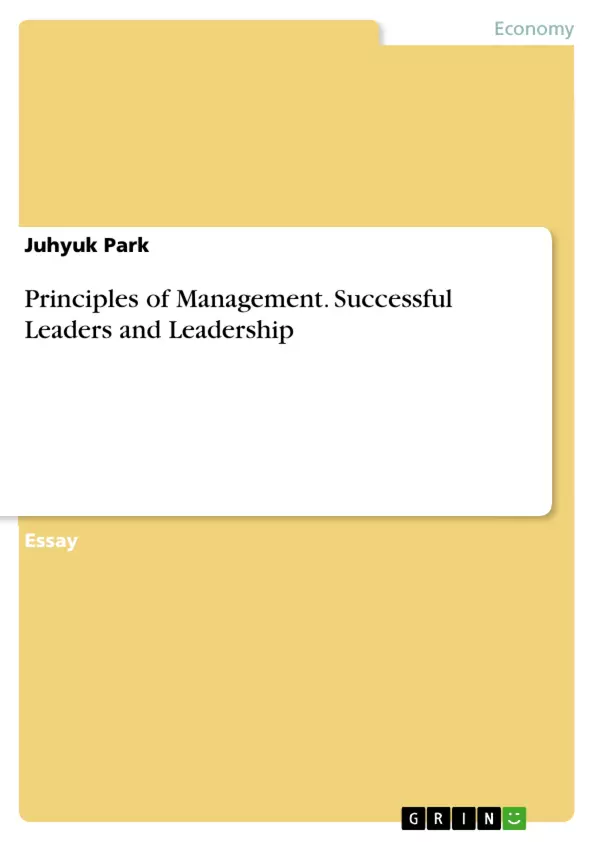In this essay the question "How to be a successsful leader?" will be shortly analysed. Therefor the criterias for successful leadership are explained.
A leader in an organization is one of the crucial elements to be successful. How a leader performs leadership in the organization changes entire results in positive ways, and even negative ways. There are many things to understand to be a good leader: what are a leader and leadership, and what a leader needs to perform good leadership. In addition, we need to know how we can cultivate good leaders.
Table of Contents
- 1. What are a leader and leadership?
- a. Transformational Leadership
- b. The influence of a leader
- 2. What do leaders need?
- a. Power
- b. Ethics
- c. Valuable failure
- 3. How can a leader cultivate other leaders?
Objectives and Key Themes
This text aims to explore the multifaceted nature of leadership, examining its definition, essential components, and methods for cultivating future leaders. It analyzes successful leadership styles and their impact, highlighting the importance of ethical conduct and the ability to learn from failures.
- Defining leadership and its core components
- The role of power and ethics in effective leadership
- The significance of transformational leadership
- The impact of a leader's influence, both positive and negative
- Strategies for cultivating and developing future leaders
Chapter Summaries
1. What are a leader and leadership?: This chapter defines leadership as the process of influencing and inspiring individuals towards achieving group or organizational goals. It uses the example of Lee Kun-hee, CEO of Samsung, to illustrate a human-oriented leadership style focused on talent cultivation and sincere care for subordinates. The chapter introduces transformational leadership, emphasizing its ability to motivate followers for both personal and organizational growth and to foster autonomy. The impact of a leader's influence is also discussed, showcasing both the potential for significant positive change (as seen in Darwin Smith's turnaround of Kimberly-Clark) and the possibility of negative consequences if leadership is applied inappropriately or in unsuitable contexts (as exemplified by the case of David Cotsonas).
2. What do leaders need?: This chapter delves into the essential qualities and resources required for effective leadership. It highlights the importance of power, specifically exploring five types of power—legitimate, reward, coercive, expert, and referent—and their impact on subordinate behavior. The chapter emphasizes the critical role of ethical conduct, illustrating the potential downfall of leaders who compromise their integrity. The concept of learning from failures is introduced, although the specific details are not fully explained in the provided text excerpt. The importance of finding a balance between various forms of power to avoid hindering subordinate growth is emphasized.
Keywords
Leadership, transformational leadership, power, ethics, influence, talent cultivation, organizational success, failure, autonomy, employee development.
Frequently Asked Questions: A Comprehensive Guide to Leadership
What is the text about?
This text is a comprehensive preview of a publication exploring the multifaceted nature of leadership. It delves into the definition of leadership, essential components for effective leadership, and strategies for cultivating future leaders. The preview includes a table of contents, objectives and key themes, chapter summaries, and keywords.
What are the main topics covered in the text?
The text covers several key areas related to leadership, including: defining leadership and its core components; the role of power and ethics in effective leadership; the significance of transformational leadership; the impact of a leader's influence (both positive and negative); and strategies for cultivating and developing future leaders. Specific examples of leadership styles and their outcomes are analyzed.
What types of leadership are discussed?
The preview specifically mentions transformational leadership, highlighting its ability to motivate followers for personal and organizational growth and to foster autonomy. It also implicitly discusses other leadership styles through examples illustrating both positive and negative outcomes of different approaches.
What are the key components of effective leadership according to the text?
Effective leadership, as described in the preview, requires a combination of factors including: a clear understanding of the process of influencing and inspiring individuals; the skillful application of various types of power (legitimate, reward, coercive, expert, and referent); unwavering ethical conduct; and the ability to learn from failures. The text emphasizes finding a balance in the use of power to avoid hindering subordinate growth.
How does the text illustrate the importance of ethics in leadership?
The text emphasizes the critical role of ethical conduct in effective leadership, implying that compromising integrity can lead to the downfall of leaders. While specific examples aren't detailed in the preview, the importance of ethical leadership is clearly highlighted as a core component of success.
What role does learning from failure play in leadership development?
The preview mentions the importance of learning from failures in leadership, although the specific details regarding this concept aren't fully explained in the provided excerpt. The importance of learning from mistakes is presented as a crucial aspect of effective leadership development.
What strategies for cultivating future leaders are discussed?
The text highlights the importance of talent cultivation and sincere care for subordinates as key strategies for developing future leaders. The preview uses the example of Lee Kun-hee, CEO of Samsung, to illustrate a human-oriented leadership style focused on these aspects.
What are some examples used to illustrate leadership styles and their outcomes?
The preview utilizes several examples: Lee Kun-hee (Samsung) to illustrate a human-oriented, talent-cultivating leadership style; Darwin Smith (Kimberly-Clark) showcasing positive change through effective leadership; and David Cotsonas to exemplify the negative consequences of inappropriate leadership application.
What are the key words associated with this text?
Key words associated with the text include: Leadership, transformational leadership, power, ethics, influence, talent cultivation, organizational success, failure, autonomy, and employee development.
- Arbeit zitieren
- Juhyuk Park (Autor:in), 2018, Principles of Management. Successful Leaders and Leadership, München, GRIN Verlag, https://www.grin.com/document/985481



